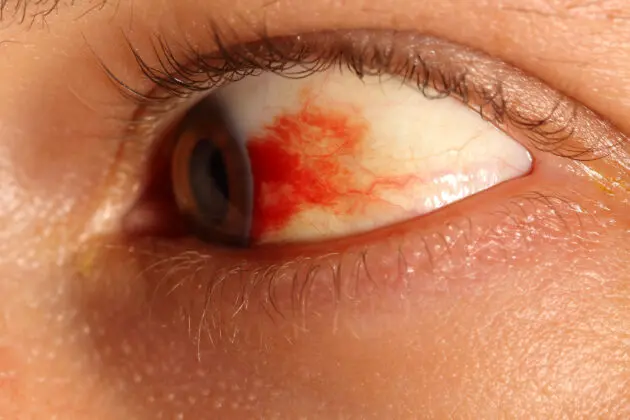
Contents
Subconjunctival Hemorrhage is a condition when one or more blood spots appear on the white part of your eye. It mainly occurs due to the breakage of a tiny blood vessel located underneath the clear surface of your eye (conjunctiva). The tiny tissue covering the sclera is known as the conjunctiva. Conjunctiva is the outermost protective layer of the eyeball. The conjunctiva is unable to absorb blood instantly, so the gets trapped.
A subconjunctival hemorrhage looks bright red or dark red patch on the white area of the eye. People might not even realize that they have a subconjunctival hemorrhage until they look in the mirror and notice that the white part of their eye has turned bright red. You may feel mild irritation in the eye occasionally.
Sometimes a subconjunctival hemorrhage can appear without any obvious harm to your eye. A blood vessel can break by even a strong sneeze or cough. There is no need for treating it. Your symptoms might get you worried but a subconjunctival hemorrhage is generally a harmless condition that will disappear within two weeks or so.
It will not always be possible to track the exact cause of a subconjunctival hemorrhage. But there are some possible factors.
Newborn babies are more likely to develop a subconjunctival hemorrhage during childbirth. They can also be seen in menstruation.
The most obvious symptom of a subconjunctival hemorrhage is a dark red or a bright red patch on the white (sclera) of your eye. Even if it appears red and bloody it should not be a harm to your vision, no discharge from your eye is witnessed, and also no pain. Your only discomfort might be a scratchy and irritating feeling on the surface of your eye.
In most cases, subconjunctival hemorrhages are spontaneous and are not linked to any specific risk factors. In case the nature of subconjunctival hemorrhage is not spontaneous then risk factors may include trauma to the eye, use of contact lenses, eye surgery, using some medication that may inhibit clotting or encourages bleeding, and disease that decreases the platelet count or vascular fragility. Due to its connection between increased vascular fragility and advancing age, being older also includes an increased risk of conjunctival hemorrhage.
Health complications occurring due to subconjunctival hemorrhage are very rare. In case your hemorrhage is due to trauma, your eye doctor may examine your eye to ensure that you do not possess any other eye complications or injuries.
In case you are taking aspirin or blood thinners, then continue to use them unless it is not instructed by your doctor to do otherwise. In case your subconjunctival hemorrhage has an identifiable cause, such as bleeding disorders or blood-thinning medication, then visit your doctor if possible and ask him what possible steps can you take to reduce the risk of subconjunctival hemorrhage.
If you really need to rub your eye, then do it gently. If you do it too hard it can cause minor trauma to your eyes, which may lead to a subconjunctival hemorrhage.
Eye drops and lubricant artificial tears can soothe the eye, though they cannot help in repairing blood vessels. Eye drops will get rid of the scratchy feeling in your eye. Avoid touching the eyes, as this can cause rebleeding. Complications in treatment are rare unless the injury is due to trauma, in which case the doctor has to conduct eye tests to see if any other complications have occurred.
Call a doctor, or schedule an appointment with an ophthalmologist (the doctor who specializes in eye care and eye surgery) if the eye blood does not get better or does not lessen in two weeks or the problem has happened multiple times. Also, contact the doctor if bleeding occurs in both eyes at once, as this could be due to the onset of easy bruising or bleeding gums. Consult a doctor immediately if:
Obtain your blood test to find out if you have a serious problem that has to be treated, like a bleeding disorder.
The doctor may prescribe eye drops or other medicines to promote healing. Antibiotic drops and ointment may also be recommended. The blood normally gets absorbed by the eye within a week or two. Thus, you may not need any treatment at all. The affected area may happen to change color, like a bruise. This happens because the body is healing, and there is no need to worry. The effects are not long-term. There is no scarring or vision loss. Very rarely, a serious problem can occur.
This may happen if the bleeding is in the same location as the eye multiple times. This means that there is an abnormally fragile capillary within the conjunctiva, which has thin walls, and it bursts spontaneously. The eye doctor can identify this problem and close the blood vessel by using heat from a laser or diathermy unit.
As the condition gets better, you might observe changes in your eye’s appearance. The area of the blood patch might increase in size. It might turn yellow or pink. If this is the case, then it is normal and not a cause for concern. Gradually, it would return to normal.
In case you have a recurring subconjunctival hemorrhage or any other bleeding, visit your doctor.
Doctors can easily diagnose eye blood by simply looking at the eye. No other tests are generally needed. If the condition is recurrent, the doctor has a simple set of questions that you may have to answer. These include:
The best way to treat your eyes is to visit your eye care professional and get your eyes checked regularly. He will be able to assess the best method of treatment for your eye ailment.
Visit our website Eyemantra.
To book an appointment call +91-9711115191 Or mail us at eyemantra1@gmail.com.
Our other services include Retina Surgery, Specs Removal, Cataract Surgery, and many more.